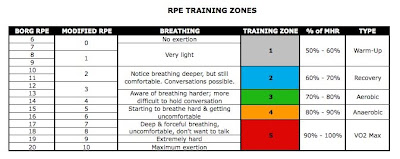The Target Zone is the range of heart rates that is optimal for fitness benefits without risking injury or overexertion. The recommended target zone is of 60 to 90 percent of your maximum heart rate.
This target zone is allows a lot of room to vary the intensity of workout. It is very good with interval training where you alternate between 60% and 90%. Of course, this is simply a target zone, emphasis on target. As a result, if you are new to a level of fitness then exercising around 50% is perfectly acceptable. In addition, if you are training for an athletic event or would like to step up a level, going to 95% is fine as well.
In order to calculate the target zone:
Target Zone = 220 - (Age)
Then calculate 60 percent and 90 percent of this number for the low and high end of target zone.
This estimate is an extremely rough estimate, as it is tailored to suit the average person. However, you're fitness level could be higher or lower than the average person's heart rate. An easier way to measure your target zone is with the RPE scale where it is based on your own qualitative observations for breathing. Look at the table to see where you are:
In general, it has been found that the fitter you are, the lower your resting heart rate is. Most people's resting heart rates fall between 60 and 90 beats per minute, while fit people tend do be around 40 to 50. However, even olympic athletes have much higher resting heart rates, so it is not an automatic indicator of fitness. This is because it also has a genetic component to it.
The reason why your resting heart rate should decrease with greater training is because your cardiovascular system becomes more efficient, so your heart requires fewer pumps to circulate your blood.
Similar to resting heart rate, there is a correlation between how much you perspire and your level of fitness. In general it is a positive trend, where the fitter person starts perspiring earlier in the workout and more profusely. This is due to the fact that a fit person's body would be able to recognize the buildup of heat sooner, allowing it to work up a sweat to avoid overheating. Since sweating is your body's cooling system, it makes sense. But again, this is not a clear indicator as it is also based on how active a person's sweat glands are which is genetically determined.

No comments:
Post a Comment